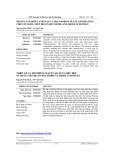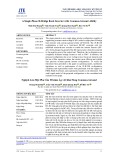
CÔNG NGHỆ https://jst-haui.vn Tạp chí Khoa học và Công nghệ Trường Đại học Công nghiệp Hà Nội Tập 60 - Số 9 (9/2024)
164
KHOA H
ỌC
P
-
ISSN 1859
-
3585
E
-
ISSN 2615
-
961
9
A 2-PHASE HYBRID BOOST CONVERTER WITH SHARED BOOTSTRAP CAPACITOR ACHIEVING 90% EFFICIENCY AT 5.0 CONVERSION RATE
THIẾT KẾ BỘ CHUYỂN ĐỔI NÂNG ÁP 2 PHA CẤU TRÚC LAI CÙNG VỚI MẠCH BOOTSTRAP SỬ DỤNG CHUNG TỤ ĐẠT HIỆU SUẤT 90% TẠI HỆ SỐ CHUYỂN ĐỔI 5.0 Pham Xuan Thanh1, Tran Hong Quan1, Kieu Xuan Thuc1, Hoang Manh Kha1,* DOI: http://doi.org/10.57001/huih5804.2024.311 ABSTRACT Many devices now require a higher voltage supply than its predecessors. This has enabled the development of hybrid boost
topology, which proved to have
a higher conversion rate, though not without its own problems, especially the hard-
charging of capacitors. This work introduces a voltage converter that
eliminates hard-charging losses by ensuring that the flying capacitors c
harge and discharge through inductors. The design is simulated in the Cadence 180nm
CMOS process. The step-up power conversion from the input voltage of 2 - 4.2V to 15 - 20V output voltage, providing 1.3 -
5W output power at 2MHz operating
frequency. The simulation result shows a peak efficiency of 90% at 3.3V input voltage and 16.5V output voltage. Keywords: DC-DC converter, 2-phase hybrid boost, soft charging, capacitor cross-connected, shared capacitor bootstrap. TÓM TẮT Nhiều thiết bị hiện nay yêu cầu nguồn điện áp cao hơn so với các thiết bị đời trước. Xu hướng này đã tạo điều kiện cho sự phát triển của m
ạch chuyển đổi
nâng áp cấu trúc lai, được chứng minh là có tỷ lệ chuyển đổi cao hơn so với mạch nâng áp truyền thống, mặc dù vậy, cấu trúc lai tồn lại những vấn đề riêng c
ần
được khắc phục, đặc biệt là vấn đề về sạc cứng trên các tụ điện. Đề tài này nghiên cứu và thiết kế m
ột bộ chuyển đổi điện áp giúp loại bỏ tổn thất do sạc cứng
bằng cách đảm bảo rằng các tụ điện được sạc và xả qua các cuộn cảm. Thiết kế của bộ chuyển đổi đư
ợc mô phỏng bằng phần mềm thiết kế vi mạch Cadence
180nm CMOS. Bộ chuyển đổi nâng áp hoạt động với điện áp đầu vào 2 - 4,2V và cung cấp điện áp đầu ra 15 - 20V, công suất đầu ra đạt 1,3 - 5W
ở tần số hoạt
động 2MHz. Kết quả mô phỏng cho thấy hiệu suất cực đại đạt 90% ở điện áp đầu vào 3,3V và điện áp đầu ra 16,5V. Từ khóa: Bộ chuyển đổi DC-DC, mạch nâng áp 2 pha cấu trúc lai, sạc mềm, tụ điện mắc chéo, mạch bootstrap sử dụng chung tụ. 1Hanoi University of Industry, Vietnam *Email: khahoang@haui.edu.com Received: 15/4/2024 Revised: 02/6/2024 Accepted: 27/9/2024 SYMBOL Symbol
Unit
Meaning VG V Pulse controls the power transistor VS V pulse control does not pass through the bootstrap I mA Current V V Voltage ΔI mA Current ripple ΔV mV Voltage ripple fSW MHz Switching frequency TSW μs Operating cycle TON μs Inductor charging time

P-ISSN 1859-3585 E-ISSN 2615-9619 https://jst-haui.vn SCIENCE - TECHNOLOGY Vol. 60 - No. 9 (Sep 2024) HaUI Journal of Science and Technology 165
TOFF μs Inductor discharge time L H Inductance C F Capacitance ABBREVIATIONS DC Directional Current IoT Interner of Things SoC System-on-a-Chip RMS Root mean square ESR Equivalent Series Resistance DSD Double-step-down CCC Capacitor Cross-Connected CMOS Complementary Metal-Oxide-Semiconductor
CR Conversion Rate NMOS N-channel Metal-Oxide-Semiconductor D Duty cycle PWM Pulse Width Modulation CLK Clock 1. INTRODUCTION Currently, system on chip (SoC) serves as an essential technology for small mobile systems that consume little energy, such as Internet of things (IoT) devices, smartphones [1, 2]. Multiphase DC-DC converter is implemented to lower input current ripple and increases output current [3] by equally splitting delivered current to each phase. However, control signals and inductors mismatches caused current imbalance, inducing a higher current stress on specific phases leads to lowered output current, higher ripple and RMS current loss, overall degrading components quality. The previous works [4-6] proposed solution by implementing current sensor circuits and balancing control schemes, requiring additional power consumption and increase complexity. Additionally, conventional boost converter with a high step-up output voltage suffers from high voltage stress on power transistors [7], which need high-voltage processes resulting in increased silicon area and cost overhead, also parasitic capacitance. Therefore, flying capacitors was implemented to stack up voltage, but capacitor hard-charging causes ESR loss [8, 9]. As explained in [10], soft-charging operation requires capacitor charging and discharging through a current source, or an inductor, exclusively. Moreover, conventional boost converters face issues with gate control signal pulse width (TOFF). A sufficiently long TOFF is required for gate drive and feedback loop propagation, resulting in a longer TS (switching period), increased IL, and the need for larger inductors due to limited operating frequency. To extend the pulse width without compromising performance, double-step-down (DSD) topologies provide a solution [8], though it has a higher output current ripple compared to traditional boost converters. In this paper, a two-phase flying capacitor cross-connected (CCC) boost converter is presented, having a high CR and power density. It effectively eliminated CF hard-charging, narrow pulse width, and output current ripple issues. More details are presented in subsequent sections. 2. PROPOSED DESIGN OF 2-PHASE HYBRID BOOST CONVERTER Fig. 1 shows the proposed variation of Switched Capacitors topology for Boost Converter, more specifically a newly introduced 2-Phase Hybrid structure. For details, the circuit presented a 2-Phase Hybrid Boost Converter mentioned above which is practically a conventional 2-Phase Boost Converter that use NMOS exclusively but also having a little twist of containing a pair of cross-connected capacitors along with a pair of inductors which differentiated the work from conventional Switched Capacitors architecture, hence the name “hybrid”. With the problem of inductor currents ripple as mentioned above, we exploited the factor of having multiple phases in order to implement two different inductors for each phase which means the ΔIL will cancel each other out and effectively reduce the currents ripple.
L
1
L
2
M
1
M
2
M
3
M
4
M
5
M
6
V
C1
V
C2
V
O
V
IN
C
O
V
S1
V
S2
V
G3
V
G4
V
G6
V
G5
C
F2
C
F1
M
1,2
: 12000µ/0.35µ
M
3,4,5,6
: 6000µ/0.35µ
Fig. 1. 2-Phase Hybrid Boost Converter Fig. 2 shows the circuit's operations with two distinct phases, each phase can be broken down into state 1-3. In state 1, M1, M3, and M5 are turned on, grounding inductor L1 and allowing it to charge. Simultaneously, L2 discharges through two flying capacitors, CF1 and CF2, due to the activation of switches M3 and M5. M1 connects CF1

CÔNG NGHỆ https://jst-haui.vn Tạp chí Khoa học và Công nghệ Trường Đại học Công nghiệp Hà Nội Tập 60 - Số 9 (9/2024)
166
KHOA H
ỌC
P
-
ISSN 1859
-
3585
E
-
ISSN 2615
-
961
9
to the ground, causing its voltage level to rise to VOUT/2, while CF2 discharges to supply our load. In state 2, a similar process occurs, but M2, M4, and M6 are active instead, L1 is discharged while L2 is charged through CF1 and CF2 via switches M4 and M6. M2 connects CF2 to the ground, raising its voltage to VOUT/2, and CF1 discharges to the load. In state 3, both M1 and M2 are turned on while the rest of the switches (M3-M6) are turned off. This configuration effectively shorts both inductors to the ground through M1 and M2, allowing them to maintain the charge between CF1 and CF2 while charging them in preparation for the next iteration of the operating circle. Two operating phases, phase 1 and phase 2, create an iterative loop operates sequentially from phase 1 (state 1 → state 3) → phase 2 (state 2 → state 3) → phase 1 (state 1 → state 3) and so on. This operating scheme minimizes current ripples while providing a continuous output current during both state 1 and state 2, enhancing the overall efficiency and performance. Fig. 2. Steady-state operation of the converter Each inductor is charged by shorting to ground in DTSW and discharged through two flying capacitors in (1 – D)TSW. Voltage that is generated by the inductor in a discharge period equal to VIN/(1 – D), charging a flying capacitor being shorted to ground. Storing a voltage of VIN/(1 – D) on the flying capacitor, in the next period, the other inductor worked as the same and applying a voltage of VIN/(1 – D) on the opposite terminal of the flying capacitor, thus, a voltage equals to 2·VIN/(1 – D) is delivered to output, in turns deriving a conversion ratio:
2
CR
1D
(1) that double the conversion ratio compared to conventional 2-Phase Boost converter. Additionally, higher output voltage means the voltage stress will be a major problem if not dealt with correctly. Table 1 provide an overview on voltages stress across all six NMOSs. Table 1. Voltage stress on switches State M1 M2 M3 M4 M5 M6 1 0 VO/2 0 VO 0 VO/2 2 VO/2 0 VO 0 VO/2 0 3 0 0 VO/2 VO/2 VO/2 VO/2 As observed, VDS3 and VDS4 became VO in state 2 and 1, respectively while having a stress of VO/2 at state 3 but with the rest of our switches only experience a voltage of VO/2. Thus, low VDS ratings devices can be implemented for M1, M2, M5, M6 for reducing in both the required silicon area and the parasitic capacitance while in theory still use higher VDS ratings devices for M3, M4 in order to maintain the circuit’s operation integrity which is a problem we can easily bypass with using the same devices as M1, M2, M5, M6 but with an increase in quantity and connect them in parallel. IL on each phase and VCF on its opposite phase have a dependency relation to each other. That relation will ensure the balance of inductors currents even when we take the possibilities of differences in inductors, capacitors values and gate driving signals, thus eliminating the need for complex control schemes in order to manage the imbalanced currents and ensuring the reliability of the circuit.
EA
SOFT START
V
RAMP
2
×f
sw
R
1
R
2
C
2
C
2
C
3
R
3
R
DIV
2-PHASE
GENERATOR
P1
P2
NON-
OVERLAP
f
sw
V
S3
V
S4
V
S5
V
S6
V
SA,SB,SC
V
S1
V
S2
BOOTSTRAP
GENERATOR
V
IN
L
1
L
2
M
1
M
2
M
3
M
4
M
5
M
6
V
O
C
O
V
S1
V
S2
V
G3
V
G4
V
G6
V
G5
C
F2
C
F1
V
G3
V
G4
V
G5
V
G6
Fig. 3. Voltage mode control loop For precise voltage regulation, a control feedback loop is implemented. Output voltage VO is fed to inverting input of error amplifier for negative response, while non-inverting input is set to a reference voltage VREF. Controlled by a voltage mode scheme, a type 3
L
1
L
2
M
1
M
2
V
O
V
IN
C
O
V
S1
V
S2
C
F2
C
F1
V
C1
V
C2
L
1
L
2
M
1
M
3
M
5
V
C1
V
C2
V
O
V
IN
C
O
V
S1
V
G3
V
G5
C
F2
C
F1
L
1
L
2
M
1
M
2
V
O
V
IN
C
O
V
S1
V
S2
C
F2
C
F1
V
C1
V
C2
L
1
L
2
M
2
M
4
M
5
M
6
V
C1
V
C2
V
O
V
IN
C
O
V
S2
V
G4
V
G6
V
G5
C
F2
C
F1
I
L1
I
L2
I
L1
I
L2
I
L1
I
L2
I
L1
I
L2
I
CF1
I
CF2
I
CF1
I
CF2
State 3 State 1
State 2 State 3

P-ISSN 1859-3585 E-ISSN 2615-9619 https://jst-haui.vn SCIENCE - TECHNOLOGY Vol. 60 - No. 9 (Sep 2024) HaUI Journal of Science and Technology 167
compensation network is implemented for stability and transient response. The difference between error amplifier’s inverting input (VFB) and non-inverting input (VREF) is amplified and compared to a sawtooth wave-form VRAMP working at 2×fSW by the comparator, generating a 2×fSW PWM signal. By using a digital logic circuit, 2-phase control signal is generated, working at fSW frequency. Duty cycle time period applied to power stage can be calculated from PWM signal’s duty cycle by:
PWM
1DD2
(2) indicates that, the lowest operating duty cycle is D = 0.5 when DPWM = 0. To prevent shoot through between M1 and M4 (M3 and M2), a non-overlapping circuit is needed.
LS
LS LS
LS
LS
C
B34
V
G3
V
G6
V
B
C
B6
V
S3
V
SB
V
SA
V
S5
V
S6
M
D6
M
B
M
C
M
A
LS
LS
V
G5
C
B5
V
S6
V
S5
M
D5
LSLS V
S4
V
SB
M
A,B,C
: 1.2m/0.5µ
M
D5,6
: 30µ/0.3µ
V
G4
Fig. 4. Gate-drive circuit with shared bootstrap capacitor scheme In this work, certain NMOS switches shown in Fig. 4, including M3, M4, M5, and M6, require bootstrap voltage due to their floating sources, which is crucial for properly operating. A typical bootstrap circuit comprises of a bootstrap capacitor (CBOOT), a voltage source providing charge to the bootstrap capacitors (VBOOT), and the NMOS's source voltage (VS). The gate-source voltage (VGS) generated by the bootstrap circuit is essentially the difference between VBOOT and VS when VS is at a low level. To optimize efficiency and minimize component quantity, the operation timing of M3, M4, M5, and M6 can be leverage. These switches operate at different time intervals, thus allowing us to implement a shared bootstrap capacitor, CB34, which reduces the overall area required for bootstrap capacitors. Furthermore, there is a need for different voltage levels of VBOOT for M3 and M5 (and M4 and M6) due to differences in their source voltage levels. However, a single shared voltage source, VC,B34, operating at a high level, can effectively charge both CB5 and CB6. This approach simplifies the bootstrap circuitry while maintaining the necessary voltage levels for proper gate driving. By employing the shared bootstrap capacitor and voltage source strategy, we achieve efficient gate driving for the NMOS switches in a streamlined and area-efficient manner. 3. SIMULATION RESULTS In this paper, a 2-Phase Hybrid Boost converter is simulated. For small size and reducing inductor current ripple, 3.3µH inductors is used. Owing to Capacitor Cross-Connected (CCC) implementation, flying capacitors values can be reduced to 470nF, a 10µF output capacitor is implemented to filter out the output voltage ripple. Fig. 5(a) shows steady-state waveforms at VIN = 3.3V, CR = 5, IOUT = 97mA. As observed, output voltage is regulated with output voltage error about 2.43%. Output voltage ripple ΔVO ≈ 1mV is detected which smaller than single-phase boost converter owing to interleaved inductor currents. V1 and V2 represent voltage stress on M1, M2 switching between 0 and VO/2 is halved by implementation of flying capacitors. Fig. 5(b) illustrates input current waveform IIN and inductor current waveforms IL1 and IL2. As observed, input current ripple ΔIIN is reduced due to the cancellation between IL1 ripple and IL2 ripple which reduces RMS input current as a benefit of multiphase configuration.
1 mV
a)
I
IN
I
L2
I
L1
I
CF2
I
CF1
b) Fig. 5. Measurement of steady-state input currents, inductors currents and flying-capacitor currents waveforms

CÔNG NGHỆ https://jst-haui.vn Tạp chí Khoa học và Công nghệ Trường Đại học Công nghiệp Hà Nội Tập 60 - Số 9 (9/2024)
168
KHOA H
ỌC
P
-
ISSN 1859
-
3585
E
-
ISSN 2615
-
961
9
Fig. 6(a) presents bootstrap voltage waveforms and control clock signal generated from PWM controller. VB34 is shifted up by the bootstrap generator with bottom plates voltage is V12 which is V1 and V2 at high level. For trading-off between size and capacitor gate charge, a 1.2nF bootstrap capacitor is used for CB34, two others bootstrap capacitors CB5 and CB6 can be smaller are implemented by two 1nF capacitors. A 5.5V external voltage source is needed to charge the main bootstrap capacitor CB34, determining driving gate-source voltage of power switches. Fig. 6(b) shows SA, SB, SC control signal waveforms determining the CB34’s charging and discharging time with V1 and V2 as bottom plate voltage, respectively.
C
LK
V
BOOT34
V
12
a)
S
A
S
C
S
B
b) Fig. 6. Measurement result of bootstrap circuit’s waveform Fig. 7(a) shows conversion power efficiency at VIN = 3.3V, output voltage is regulated from 15 - 20V, peak efficiency reaches 90% at conversion ratio CR = 5, corresponding to 16.5V output voltage. Output voltage’s transient response is tested by applying stepping load current, simulation result in Fig. 7(b) shows overshoot/undershoot at output voltage approximate 3% compared to regulated output. Table 2 represents comparison this paper with others DC-DC Boost converter topology. a)
Overshoot/Undershoot ≈ 3% Output
b) Fig. 7. Efficiency to load impedance Table 2. Comparison table to other papers Specifications This paper [7] [8] [11] CMOS Process (nm)
180 NA NA 35 Topology Hybrid CCC Conventional
Hybrid Hybrid Input voltage (V) 2 - 4.2 4.5 - 27 6 - 18 3.3 - 8 Output Voltage (V)
15 - 20 4.5 - 38 12 - 50 12 - 14.4
Load Current (mA)
8.6 - 250 20 - 120 70 - 100 NA FSW (MHz) 2 1 0.82 0.5 Multi-Phase Yes No No Yes CR
2
1D
1
1D
3D
1D
Fly. Cap. (μF) 2×0.47 NA 2x260 Soft Charging Yes NA No Peak Efficiency @ (CR) 90% (CR = 5) 94% (CR = 1.67) 92% (CR = 2.5) 4. CONCLUSIONS In this paper, a 2-Phase Hybrid Boost converter is proposed and simulated by using CMOS 180 nm process.




![Các thiết bị đo lường cơ bản: Nguyên lý hoạt động [Chuẩn nhất]](https://cdn.tailieu.vn/images/document/thumbnail/2019/20190309/quocthaitn/135x160/7901552107683.jpg)
![Đèn Led: Hiệu suất năng lượng [TỐT NHẤT]](https://cdn.tailieu.vn/images/document/thumbnail/2018/20180920/khuong-elink/135x160/8601537423106.jpg)
![Mạch điện tử hay ứng dụng cho thực tế: Tổng hợp một số mạch [mới nhất]](https://cdn.tailieu.vn/images/document/thumbnail/2015/20151120/caotan1422/135x160/284835042.jpg)
![50 mạch điện tử cảm biến [tốt nhất/ phổ biến]](https://cdn.tailieu.vn/images/document/thumbnail/2015/20151120/caotan1422/135x160/459492351.jpg)
![OrCAD Capture 9.2: Chương 3 [Hướng Dẫn Chi Tiết]](https://cdn.tailieu.vn/images/document/thumbnail/2015/20150321/taikhoantatca/135x160/1748098_157.jpg)


![Trắc nghiệm Mạch điện: Tổng hợp câu hỏi và bài tập [năm hiện tại]](https://cdn.tailieu.vn/images/document/thumbnail/2025/20251118/trungkiendt9/135x160/61371763448593.jpg)














